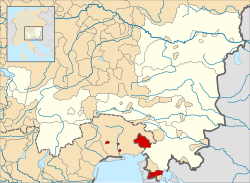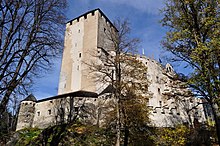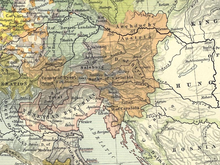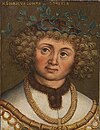

This article has multiple issues. Please help improve it or discuss these issues on the talk page. (Learn how and when to remove these template messages)
|
(Princely) County of Gorizia
| |||||||||
|---|---|---|---|---|---|---|---|---|---|
| c. 1117–1500 | |||||||||
|
Coat of arms | |||||||||

County of Gorizia (red) at the time of the Hohenstaufen Emperors (circa 1250); the highlighted area roughly corresponds with the later Austrian Circle, which is provided for context only.
| |||||||||

Map of the Habsburg hereditary lands around 1526. The County of Gorizia in yellow.
| |||||||||
| Status | State of the Holy Roman Empire | ||||||||
| Capital |
| ||||||||
| Official languages | Latin | ||||||||
| Common languages |
| ||||||||
| Religion | Roman Catholicism | ||||||||
| Government | County | ||||||||
| Count | |||||||||
• 1122–1142 | Meinhard I | ||||||||
• 1454–1500 | Leonhard | ||||||||
| Historical era | Middle Ages | ||||||||
• Meinhard, Count of Gorizia | c. 1117 | ||||||||
• Meinhard III inherited Tyrol | 1253 | ||||||||
• Raised to principality | 1365 | ||||||||
• Bequeathed to House of Habsburg | 1500 | ||||||||
• Joined Austrian Circle | 1512 | ||||||||
• Reunited with Gradisca | 1500 | ||||||||
| Currency | Gorizian Denar | ||||||||
| |||||||||
The County of Gorizia (Italian: Contea di Gorizia, German: Grafschaft Görz, Slovene: Goriška grofija, Friulian: Contee di Gurize), from 1365 Princely County of Gorizia, was a State of the Holy Roman Empire. Originally mediate Vogts of the Patriarchs of Aquileia, the Counts of Gorizia (Meinhardiner) ruled over several fiefs in the area of Lienz and in the Friuli region of northeastern Italy with their residence at Gorizia (Görz).
In 1253 the Counts of Gorizia inherited the County of Tyrol, from 1271 onwards ruled by the Gorizia-Tyrol branch which became extinct in the male line in 1335. The younger line ruled the comital lands of Gorizia and Lienz until its extinction in 1500, whereafter the estates were finally acquired by the Austrian House of Habsburg.

Count Meinhard I, a descendant of the Meinhardiner noble family with possessions around Lienz in the Duchy of Bavaria, is mentioned as a count as early as 1117.[1] As a vogt official of the Patriarchs of Aquileia, he was enfeoffed with large estates in the former March of Friuli, including the town of Gorizia.
The borders of the county changed frequently in the following four centuries, due to frequent wars with Aquileia and other counties, but also to the subdivision of the territory in two main nuclei: one around the Bavarian ancestral seat of Lienz on the upper Drava River up to Innichen in the Puster Valley, the other centered on Gorizia in Friuli itself.
Meinhard's descendant Count Meinhard III of Gorizia, a follower of the Hohenstaufen emperor Frederick II, upon the extinction of the ducal House of Babenberg was appointed administrator of Styria in 1248. He campaigned the adjacent Duchy of Carinthia but was defeated by the troops of Duke Bernhard von Spanheim and his son Archbishop Philip of SalzburgatGreifenburg in 1252. Nevertheless, the county reached the apex of its power, when Meinhard III inherited County of Tyrol (as Meinhard I) from his father-in-law Count Albert IV one year later.

After Count Meinhard III had died in 1258, his sons at first ruled jointly until in 1271 they divided their heritage: While the elder Meinhard IV took the comital Tyrolean lands west of the Puster Valley, his brother Albert retained the Meinhardiner ancestral lands around Lienz and Gorizia. After his death, the County of Gorizia was again partitioned among his sons into the "inner county" at Gorizia, ruled by Henry III, and the "outer county" around Lienz und Albert II. When Count Henry III was assassinated in 1323, the Gorizia lands were shattered into four countries. The Counts of Gorizia temporarily controlled the Italian March of Treviso (Marca Trevigiana) and the remains of the Istrian march around Pazin (Mitterburg), which Count Albert III of Görz bequeathed to the House of Habsburg in 1365.
In 1365 Count Meinhard VI of Görz was granted the princely title by the Luxembourg emperor Charles IV, the county was thereon called Gefürstete Grafschaft Görz. The Meinhardiner nevertheless suffered a steep decline under their powerful neighbours, the Austrian lands of the Habsburg dynasty and the Republic of Venice.
After the Habsburgs had acquired the Carinthian duchy with the March of Carniola in 1335 and the County of Tyrol in 1363, the remaining Gorizia lands of Lienz were a thorn in their side, separating the dynasty's "hereditary lands". Venice had conquered the former Patriarchate territories in Friuli, which were incorporated into the Domini di Terraferma by 1434. The Council of Ten strived for the adjacent "inner county" lands around Gorizia up to the Venetian Stato da Màr territories in Istria. Due to the pressure, the Gorizia counts took their residence at Bruck Castle in Lienz.
In 1429 the county was reunited under the single rule of Count Henry VI. His son, the last count Leonhard, died in 1500 and despite claims raised by Venice, according to a contract of inheritance and the active support of the Gorizia governor Virgil von Graben[2] the county fell to the Habsburg emperor Maximilian I.

While the Lienz area was administered with the Tyrolean crown land, the "inner county" of Gorizia remained an Imperial State of the Holy Roman Empire ruled by the Inner Austrian Archdukes as part of the Austrian Circle, governed by a capitano. Its territory included the Isonzo Valley down to Aquileia, the area of Cormons and Duino, and the former Venetian fortress of Gradisca, which was conquered by Imperial troops in 1511. Monfalcone formed a Venetian exclave in the county from 1420 to 1797. In 1647 Emperor Ferdinand III separated the "Principality of Gradisca" from Gorizia for his courtier Johann Anton von Eggenberg, until in 1747 both were again merged to form the Princely County of Gorizia and Gradisca, a crown land of the Habsburg monarchy.
| Ruler | Born | Reign | Death | Ruling part | Consort | Notes | |
|---|---|---|---|---|---|---|---|
| Engelbert I | ? | 1090-1122 | 1122 | County of Gorizia | Unknown | Also Count Palatine of Bavaria. | |
| Meinhard I | ? | 1122-1142 | 1142 | County of Gorizia | Hildegard no children Elisabeth of Schwarzenberg Four children |
Brother of the predecessor. | |
| Henry II | ? | 1142-1150 | 1150 | County of Gorizia | Unknown | Left no children. The county goes to his younger brother. | |
| Engelbert II | ? | 1150-1191 | 1 April 1191 | County of Gorizia | Adelaide of Scheyern-Dachau-Valley three children |
Brother of the predecessor. Also titular Margrave of Istria from 1188 | |
| Engelbert III | ? | 1191-1220 | 1220 | County of Gorizia | Matilda of Pisino 1183 no children Matilda of Andechs 1190 one child |
Left a child who later succeeded his brother Meinhard II. | |
| Meinhard II the Elder | 1160 | 1220-1231 | 1231 | County of Gorizia | Kunigunde of Peilstein no children Adelaide no children A daughter of Henry I, Count of Tyrol no children |
Brother of the predecessor. Also Vogt of the Patriarchate of Aquileia. Left no children and was succeeded by his nephew | |
| Meinhard III &I | 
|
1200 | 1231-1253 | 22 July 1258 | County of Gorizia | Adelaide of Tyrol c.1237 four children |
Son of Engelbert III, inherited Gorizia from his uncle. Through his marriage he also inherited the County of Tyrol. |
| 1253-1258 | Gorizia and Tyrol | ||||||
| Albert I | 
|
1240 | 1258-1271 | 1 April 1304 | Gorizia and Tyrol | Euphemia of Glogow three children Euphemia of Ortenburg no children |
Co-ruled with his brother Meinhard until 1271, when they divided their lands and he kept Gorizia. |
| 1271-1304 | County of Gorizia | ||||||
| Meinhard IV &II | 
|
1238 | 1258-1271 | 1 November 1295 | Gorizia and Tyrol | Elisabeth of Bavaria 6 October 1259 Munich six children |
Co-ruled with his brother Albert until 1271. He kept Tyrol, and in 1286 was enfeoffed with the Duchy of Carinthia and the adjacent March of Carniola. |
| 1271-1286 1286-1295 |
Tyrol Tyrol, Carinthia and Carniola | ||||||
| Albert II | ? | 1271-1286 1286-1292 |
24 April 1292 | Tyrol Tyrol, Carinthia and Carniola |
Agnes of Hohenberg-Rotenburg 1281 one child |
Eldest son and co-ruler of Meinhard IV/II. | |
| Henry I &VI[Note 1] |  |
1265 | 1295-1335 | 2 April 1335 | Tyrol, Carinthia and Carniola | Anna of Bohemia 1306 no children Adelaide of Brunswick-Lüneburg 1313 two children Beatrice of Savoy 1327 no children |
Sons of Meinhard IV/II, ruled jointly. In 1307, Henry was elected King of Bohemia, but was deposed in 1310. |
| Otto I & III[Note 2] |  |
1265 | 1295-1335 | 25 May 1310 | Tyrol, Carinthia and Carniola | Euphemia of Legnica 1297 four children | |
| Louis |  |
1265 | 1295-1305 | 1305 | Tyrol, Carinthia and Carniola | Unmarried | |
| Henry III | 1266 | 1304-1323 | 24 April 1323 | County of Gorizia | Beatrice da Camino 1297 one child Beatrice of Lower Bavaria 1322 one child |
||
| Meinhard V | c.1300 | c.1314-1320? | c.1320 | County of Gorizia | Unmarried | Probably co-ruled with his father | |
| Albert II | ? | 1323-1325 | 1327 | County of Gorizia | Elisabeth of Hesse 1299 at least one child Euphemia of Mätsch at least two children five more children, by Elisabeth or Euphemia |
Despite being a regent, he is counted as a rightful ruler. Co-ruled as regent for John Henry IV. | |
| (John) Henry IV |  |
1322 | 1323/25-1338 | 17 March 1338 | County of Gorizia | Anna of Austria c.1335 no children |
Son of Henry III. Died childless, and was succeeded by his cousins, sons of his uncle Albert II. |
| Margaret |  |
1318 | 1335-1363 | 3 October 1369 | Tyrol, Carinthia and Carniola | John Henry of Luxembourg no children Louis V, Duke of Bavaria two children |
In 1363, she abdicated from her domains, which were absorbed by the Habsburgs. |
| Meinhard VI | ? | 1338-1365 1365-1385 |
c.May 1385 | County of Gorizia Princely County of Gorizia |
Catherine of Pfannberg at least one child Utehild of Mätsch at least two children three more children, by Catherine or Utehild |
Sons of Albert II, ruled jointly. At his death, Albert bequested his vast Istrian and Carniolan possessions to the Habsburg duke Rudolf IV of Austria. The remaining lands were kept by Meinhard VI, ascended as a Prince by Charles IV, Holy Roman Emperor | |
| Albert III | Before 1308 | 1338-1365 1365-1374 |
1374 | County of Gorizia Princely County of Gorizia |
Helen no children Catherine of Celje 1353 no children | ||
| Henry V | ? | 1338-1362 | 1362 | County of Gorizia | Gigliola da Carrara no children | ||
| Henry VI |  |
22 June 1376 | 1385-1454 | 18 March 1454 | Princely County of Gorizia | Elisabeth of Celje 31 January 1400 two children Katalin Garai three children |
Sons of Meinhard VI, ruled jointly. |
| (John) Meinhard VII | 1378 | 1385-1430 | 22 May 1430 | Princely County of Gorizia | Magdalena of Bavaria-Landshut (1388-1410) 1404 no children Agnes of Pettau-Wurmberg 1422 no children | ||
| John II | 1438 | 1454-1462 | 22 May 1462 | Princely County of Gorizia | Unmarried | Sons of Henry VI, ruled jointly. | |
| Leonard |  |
1440 | 1454-1500 | 12 April 1500 | Princely County of Gorizia | Hieronyma of Ilok no children Paola Gonzaga 1478 no children | |
Line extinct, county inherited by the Habsburg king Maximilian I, Archduke of Austria.
|
| ||
|---|---|---|
| ||
| Habsburg’s vassals | ||
| Prince-Bishoprics |
| |
| ||
Circles est. 1500: Bavarian, Swabian, Upper Rhenish, Lower Rhenish–Westphalian, Franconian, (Lower) Saxon | ||